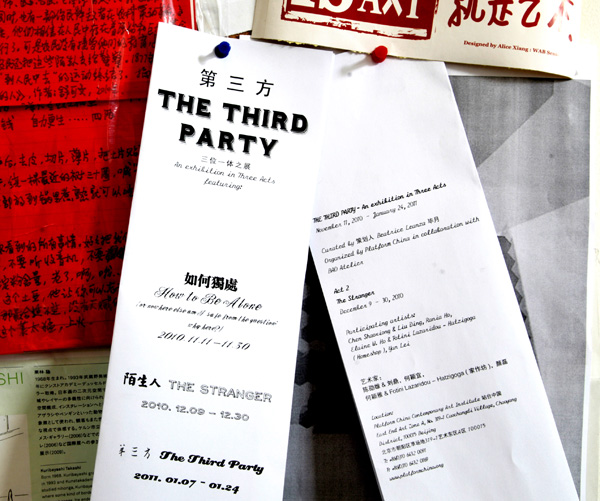
Artists: Chen Shaoxiong & Liu Ding, Rania Ho, Elaine W. Ho & Fotini Lazaridou-Hatzigoga (Homeshop), Yan Lei.
“How can a subject give an account of its own ruin?” (Giorgio Agamben, from The Archive and Testimony)
As the second enactment of this voyaging through the realm of the ordinary, The Stranger enters a very specific world of interaction, an intermediate zone of potentiality through which different manners of human relations come ‘to be lived rather than resolved’.
The stranger is, as described in the eponymous essay by Georg Simmel in 1908, the sociological form that represents a unity of both fixation and liberation, “a particular structure composed of distance and nearness, indifference and involvement”. His position within a given group is “determined, essentially, by the fact that he has not belonged to it from the beginning, that he imports qualities into it, which do not and cannot stem from the group itself”. For what matters the investigation of narrative structures and aesthetic objects set out with the realization of this project, this second exhibition chooses to engage forms of artistic enunciations that dwell in the ‘negative side of presence’. More precisely, it exposes how they operate in relation to the exterior landscape by transforming or re-assembling into new spatial configurations specific orders of signification belonging to our living image- and object-scapes.
As the first part of this project, this second chapter looks at how aesthetic strategies ‘behave’ in relation to their immediate context by simultaneously engaging and removing themselves from its habitual order, that is how they manipulate the haptic and conceptual fields of social perception into alternative forms of narrative articulations. Unlike those seen in the first act of the exhibition, the artistic practices here selected do not operate in the register of sensate perception, but within a more general economy of aesthetics intended as the arena where symbolic and ideological systems of power are being constructed. The artists and projects included in The Stranger make manifest the intrinsic structures and processes by which the collective temporality and materiality of the present is archived in the ‘objective truths and facts’ of public consciousness and through which we inherit knowledge of official historical and social orders.
This exhibition limits itself to overall four projects. Product of both individual and collaborative actions, they are accommodated in separate environments and are site-specifically arranged so to heighten the experiential interconnectedness they subtend as unique responses to the ‘range of ambivalences’ that have come to define the time and place of our contemporaneity, our cognitive and built environments. Recurrently decoded into dynamics of negotiated difference, the cultural complexity of the contemporary privileges an imagery of dichotomous nature; often laid out to mediate the subject’s position against the seemingly irreducible landscape of ‘change’ characterizing its present condition, it casts him adrift, somewhere in-between both spatial and temporal dimensions ‘of change’. Like in Simmel’s essay the icon of the stranger is here employed to renounce the syntax of ‘negotiation’ and its set of irreconcilable oppositional diversities, and resort instead to one of ‘contamination’ where the positive tensions between potentiality and contingency give way to the coming into being of totally new collective narratives.
The stranger is therefore a figure of both speech and space through which we acknowledge the presence of the remote, of what we make absent from our habitual field of vision and experience, by way of a process of ‘involved difference” (John Allen “On Georg Simmel). The image of the stranger allows the convergence of disparate models of spatial and social organization and makes them simultaneously, albeit temporarily, part of the same world order. It represents, I suspect, what Giorgio Agamben would identify as an operator of desubjectification.
The projects here presented somehow act as enablers of such encounters, they actualize the material and conceptual contingencies present in given realities and knowledge systems into alternative, possible dimensions and temporalities of ‘positive participation’.
These four installations create four very distinct zones of reflexive articulation whose objects range in urban and pictorial spaces and their corresponding vocabularies – from the politics of place to the history of art. Contingently they reference matters of theoretical and practical nature that continue to transverse, unresolved, the discourse of Chinese art. Particularly its imbrications with a decades-long process of social/urban regeneration, the flickering in-betweenness of contemporary art and artists, and the antinomic relation it beholds with Western art and its Modernity.
Designed upon different tableaus of representation, these works take place, or better actualize places engraved in both our experiential and cognitive environments by recording its living traces via forms of engagement that are both contemporaneous and personal.
These unattended, vacated signifiers are therefore not exposed as vestiges in immobile repositories of abandoned history but as as-of-yet unaccomplished realities. A peculiar sort of ‘archival impulse’ motivates these artistic practices, not a drive in search for origin or completion but for the possibility of testimony, for the possibility of individualized and subjective attestation of history within the larger system of official narratives. Unlike others forms of archival practice widely discussed in contemporary theory, the narrative utopia embedded in these works makes no space for nostalgic longing, it seeks no past to awaken in the present, but a commitment to the contingent, to the provisional, unattainable nature of witnessing.
Especially realized for this exhibition, each of the works included intentionally opens up an aesthetic dimension which both speaks of and to its own subject, somehow transforming its inherent narrativity into an abstraction of itself.
The Stranger features individual works by Rania Ho and Yan Lei, and new collaborative projects by Beijing-based Elaine W.Ho and Fotini Fotini Lazaridou-Hatzigoga as an iteration of the Homeshop project series, as well as a newly established endeavor jointly started by Chen Shaoxiong and Liu Ding, making here its first public appearance.